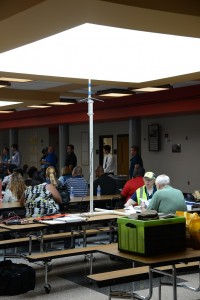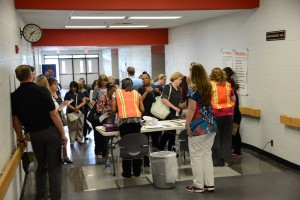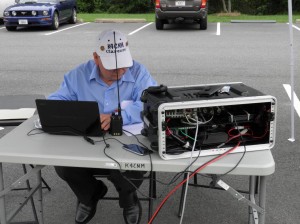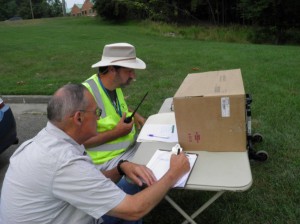Overview
Participants
- David, KG4GIY
- Brian, W4CJ
- Ray, AA4SI
- Mark, W4IAD
- Clarence, K4CNM
- Steve, KM4KWZ
- Bill, K5AE
- Mark, W3SR
- Larry, K4MLA
- Richard, KG4GFW
- Zach, K4RSU
Return to Summary
Operational Parameters
We will be testing the K3FBI repeater at 147.345+ PL 167.9, the Woodbridge machine at 147.240+ PL 107.2, and simplex at 147.525, the normal ARES operational frequency. Please ensure each of these frequencies and their PL tones are in your radio to make net changes efficient.
Each operator will be asked to take up station at one of the parking lots or crossroads as indicated on the check sheet which will be provided on Saturday morning along with a copy of the map. We will then systematically check that we can hear each other at each location around the park in each mode. You will likely want to have a pen and paper with you.
Return to Summary
Results
Thanks to those who came out and to the K3FBI repeater association and Woodbridge Wireless. The weather was overcast, the trees were mostly bare. Operators set up at the Start/Stop location, parking lots C through I, Burma Road/Scenic Drive and Oak Ridge/Scenic Drive.
Start/Stop, Lot C, and Oak Ridge utilized 1/2 wave or greater antennas, most on tripods. The rest used some form of vehicle mounted antenna. Radios were primarily mobile radios running at 50 watts. In one case, while running Simplex, Burma Road utilized an HT at 8 watts, with a small mag-mount.
The test was to evaluate the performance of two repeaters (K3FBI, WWI) and simplex for use in the passing of messages for the Marine Corps Marathon Crossroads 17.75 race, to be held April 2, 2016 in the Forest. We know that the Forest presents unique challenges for radio communications and we needed to ensure that options were available come the event day.
General Results
In all, both machines and simplex worked acceptably, with varying results of good, while simplex seemed to work the best over all. In general, the K3FBI machine performed better than the WWI machine, as expected.
Specific Results
Despite being pointed out prior to the event, we had some issues with PL tones not being pre-programmed. This resulted in negative connections. There is also one indication of location deafness which may be a machine issue, a location issue, or both between Lot I and the K3FBI machine. We also experienced difficulties communicating between Lot I and Lot G, despite there being no issues communicating between Lot I and Lot H and Lot G and Lot H. Further investigation into the geography, topology, and geology between these locations will need to be undertaken.
Start/Stop
Start/Stop was running a mobile with a full wave antenna on a tripod. In all situations, the signal between Start/Stop and other locations was solid with this set up on all machines and simplex.
Lot C
Lot C was also running a full wave antenna on a short tripod with a mobile. There were some poor signal reports on the K3FBI machine and the WWI machine. This is likely the result of topology. Simplex resulted in a good, strong signal.
Oak Ridge
Oak Ridge was also using a full wave antenna and mobile on a short tripod. Results were mixed. Reports against K3FBI were mostly strong, while against WWI, they were weak to no response, likely because of PL. Simplex was also strong.
Return to Summary
K3FBI Grid
Note (R) meant the signal was heard on the reverse, not the repeater. In one case, due to PL, in the other case, location and possibly an issues with the repeater.
| K3FBI | Start | Lot C | Lot D | Lot E | Burma | Lot F | Oak Ridge | Lot G | Lot H | Lot I |
|---|---|---|---|---|---|---|---|---|---|---|
| Start | X | 4 | 4 | 3 | 3 | 5 | 5 | 5 | 0 | 3 |
| Lot C | 3 | X | 4 | 5 | 5 | 5 | 5 | 4 | 0 | 3 |
| Lot D | 3 | 5 | X | 4 | 4 | 5 | 5 | 5 | 0 | 5 |
| Lot E | 3 | 4 | 5 | X | 5 | 5 | 5 | 5 | 0 | 5 |
| Burma | 5 | 5 | 3 | 4 | X | 5 | 5 | 5 | 0 | 5 |
| Lot F | 5 | 5 | 5 | 5 | 5 | X | 5 | 5 | 0 | 5 |
| Oak Ridge | 5 | 5 | 5 | 5 | 5 | 5 | X | 5 | 0 | 5 |
| Lot G | 0 | 0 | 0 | 0 | 5 (R) | 5 (R) | 5 (R) | X | 5 | 1 (R) |
| Lot H | 5 | 5 | 5 | 5 | 5 | 5 | 5 | 0 | X | 5 |
| Lot I | 2 | 2 | 0 | 0 | 1 | 5 (R) | 5 (R) | 5 (R) | 5 (R) | X |
Return to Summary
WWI Grid
Note Initially Oak Ridge did not have the right PL configured. It was fixed. In general, the reception on the WWI machine was not as good as it was on the K3FBI machine.
| WWI | Start | Lot C | Lot D | Lot E | Burma | Lot F | Oak Ridge | Lot G | Lot H | Lot I |
|---|---|---|---|---|---|---|---|---|---|---|
| Start | X | 3 | 5 | 5 | 5 | 5 | 5 | 5 | 5 | 4 |
| Lot C | 3 | X | 5 | 3 | 3 | 4 | 5 | 4 | 4 | 3 |
| Lot D | 3 | 5 | X | 4 | 4 | 5 | 5 | 5 | 5 | 3 |
| Lot E | 3 | 4 | 5 | X | 5 | 5 | 5 | 5 | 4 | 4 |
| Burma | 5 | 5 | 3 | 4 | X | 5 | 5 | 4 | 5 | 5 |
| Lot F | 5 | 5 | 5 | 5 | 4 | X | 5 | 5 | 4 | 4 |
| Oak Ridge | 5 | 5 | 5 | 5 | 5 | 5 | X | 5 | 4 | 5 |
| Lot G | 4 | 3 | 4 | 4 | 5 | 5 | 5 | X | 5 | 4 |
| Lot H | 5 | 5 | 5 | 5 | 5 | 5 | 5 | 3 | X | 5 |
| Lot I | 2 | 2 | 3 | 3 | 3 | 5 | 5 | 5 | 5 | X |
Return to Summary
Simplex
| WWI | Start | Lot C | Lot D | Lot E | Burma | Lot F | Oak Ridge | Lot G | Lot H | Lot I |
|---|---|---|---|---|---|---|---|---|---|---|
| Start | X | 4 | 5 | 5 | 5 | 5 | 5 | 5 | 5 | 4 |
| Lot C | 5 | X | 5 | 4 | 4 | 4 | 5 | 4 | 5 | 3 |
| Lot D | 4 | 5 | X | 4 | 4 | 5 | 5 | 5 | 4 | 5 |
| Lot E | 5 | 4 | 5 | X | 5 | 5 | 5 | 5 | 5 | 4 |
| Burma | 5 | 5 | 5 | 4 | X | 5 | 5 | 4 | 5 | 5 |
| Lot F | 5 | 5 | 5 | 5 | 4 | X | 5 | 5 | 5 | 4 |
| Oak Ridge | 5 | 5 | 5 | 5 | 5 | 5 | X | 5 | 5 | 5 |
| Lot G | 5 | 5 | 5 | 5 | 5 | 5 | 5 | X | 5 | 3 |
| Lot H | 5 | 5 | 5 | 5 | 5 | 5 | 5 | 4 | X | 5 |
| Lot I | 4 | 5 | 5 | 5 | 5 | 5 | 5 | 5 | 5 | X |
Return to Summary






